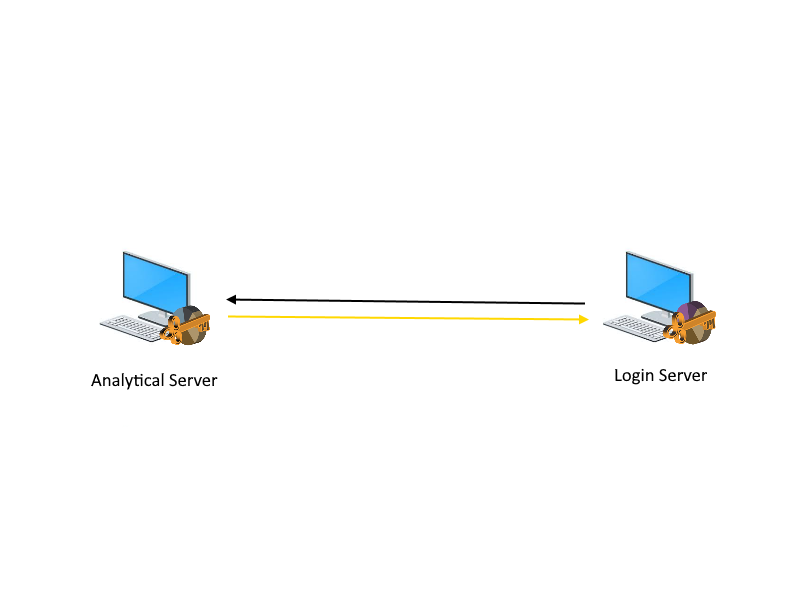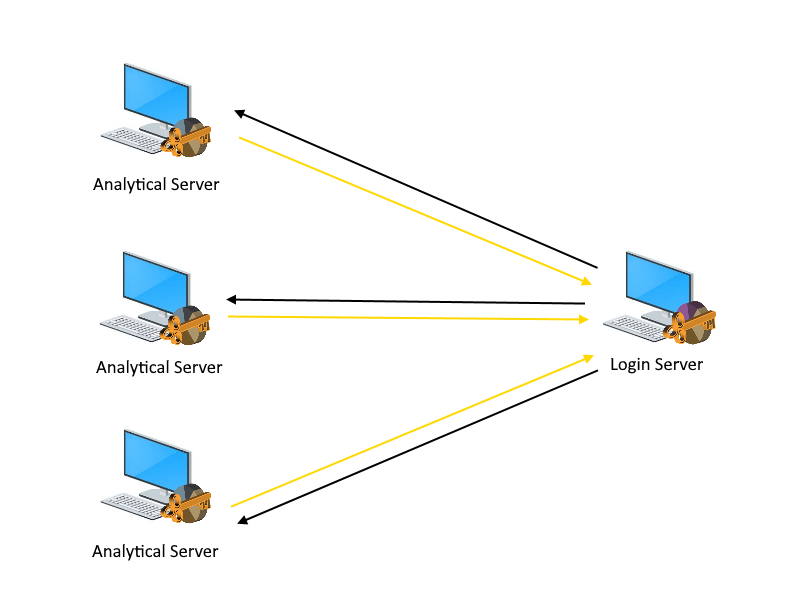Login Server Concept
Since versions 26xx and older a PolyAnalyst server consists of 2 parts, i.e. Analytical server and Login server.
The Analytical Server is the primary application of the PolyAnalyst system. There are client applications, e.g. such as Analytical Client, Administrative Tool, Scheduler and Web Report Editor which connect to the Analytical Server where some necessary calculations for the applications in hand take place, e.g. performing a node execution or saving a web report.
All "service" functions, for example, settings and passwords storage, users’ database, etc., were allocated in a separate entity called the Login Server.
The Login Server is an authorization service and a single place for storing the settings of an Analytical Server or a cluster of Analytical Servers including users' configuration.
As mentioned above, the Login Server performs "service" functions which are as follows:
-
Storing the configuration of a PolyAnalyst Analytical Server or a cluster of Analytical Servers.
-
Storing the user settings of the PolyAnalyst Analytical Server.
-
Storing users’ passwords of the PolyAnalyst Analytical Server.
We will describe the given functions in more detail further.
Interaction of the Analytical Server and the Login Server
One Analytical Server can be connected to the Login Server – in this case we will speak about the Standalone mode. Several Analytical Servers can be connected to the Login Server as well – in this case we will speak about the Cluster mode.
Thus, there are two main modes of work of the Analytical and Login Servers, which are illustrated below.
The Standalone mode

The Cluster mode

One should not consider the Analytical Server and the Login Server as completely different entities. On the contrary, they represent a certain "symbiosis", both parts of which interact with each other in the following way:
-
The Analytical Server always requires a connection to the Login Server (the Login Server must be running).
-
The version of the Analytical Server must match the one of the Login Server.
-
Configuration of the Login Server is performed via the Administrative Tool of the Analytical Server (details on the configuration of the Login Server are given further).
Functions of the Login Server
Let’s see the main functions of the Login Server which were mentioned earlier and consider them in more detail:
1) Storing the configuration of a PolyAnalyst Analytical Server or a Сluster of Analytical Servers.
After the Analytical Server is launched and connected to the Login Server, the settings of this Analytical Server are overwritten by the Login Server, i.e. all the Login Server settings are copied to the Analytical Server. There is no reverse operation.
Some settings of the Analytical Server remain on the server itself and are not subject to change by the Login Server, for example, the path to the dictionaries folder of PolyAnalyst.
2) Storing user settings of a PolyAnalyst Analytical Server.
When working in the Cluster mode, user settings changed on one of the Analytical Servers are sent to the Login Server which notifies other Analytical Servers of the changes. In other words, when user settings are changed on one of the Analytical servers, these settings are copied to the Login Server and to other Analytical servers. Then those Analytical Servers take the new configuration from the Login Server.
3) Storing users’ passwords of a PolyAnalyst Analytical Server.
The Login Server stores secrets specific to an Analytical Server, for example, the password for connecting to the Login Server.
Other functions of the Login Server are as follows:
-
Storing a list of registered users;
-
Storing a list of authenticated users and their connections;
-
Storing the saved Views of Web Reports;
-
Maintaining a centralized record of licenses.